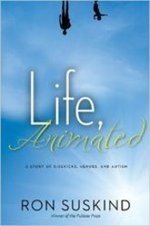Bissell, J., Fisher, J. , Owens, C., and Polcyn P.(1998). Sensory Motor Handbook: A Guide for Implementing and Modifying Activities in the Classroom (2nd ed.) Suggestions for the classroom, physical education, and recess for children K-3.
Authors have extensive experience providing occupational therapy using an SPD approach in schools.
Henry, D.(1996). Tools for Teachers Plus Other Useful Tools for Parents, Teachers, Teenagers and Others
Explains the impact of sensory-processing problems in the classroom and illustrates how to adapt the school environment. This book explains various techniques and strategies to help students with hyperactivity, distractibility and sensorimotor delays, including poor handwriting. This book also illustratesthe importance of how movement and sensory experiences are vital for learning.
Hickman, L., Hutchins, J. (2002). Seeing Clearly (2nd ed.)
Fun activities to improve visual skills with your child.
Kashman, N., Mora, J. (2005). The Sensory Connection.
An OT and speech language pathologists' team approach to treating sensory and communication disorders.
Kranowitz, C.S., Sava, D.I., Haber, E., Balzer-Martin, L., and Szklut, S. (2001). Answers to Questions Teachers Ask About Sensory Integration.
Carol stock Karonwitz and expert occupational therapists have assembled an extensive and easy to use set of checklists and other tools that are valuable to every teacher and parent who has children with sensory processing challenges.
Kranowitz, C.S. (2005). Preschool Sensory Scan for Educators (Preschool SENSE).
A valuable new tool that occupational therapists can provide to teachers who are striving to help preschoolers with Sensory Processing Disorder.
Arnwine, B. (2005). Starting Sensory Integration Therapy.
Fun, sensory based activities that can be done within the home or school.
Kranowitz, C.S. (1995). “101” Activities for Kids in Tight Spaces.
Activities for the doctor’s office, on car, train, plane trips, or home sick in bed that will engage your child in a fun, learning activity!
Kranowitz, C.S. (2003, revised 2006). The Out-of-Sync Child Has Fun: Activities for Kids with Sensory Integration Dysfunction.
A companion to The Out of Sync child: Recognizing and Coping with Sensory Integration Dysfunction, presents activities that parents and kids with SPD can do at home.
Ayres, A.J., (1972). Sensory Integration and Learning Disorders.
A classic text written by the occupational therapist/psychologist who developed sensory integration theory and intervention.
Ayres, A.J., Erwin, P., and Mailloux, Z. (2004) Love, Jean: Inspiration for Families living with dysfunction of Sensory Integration.
The story of Philip Erwin, a young man who had sensory processing difficulties, and his aunt, A. Jean Ayres, Ph.D., OTR, the scientist who pioneered the diagnosis and treatment of the disorder. The story is presented in letters from “Aunt Jeanie,” details Philip’s struggle as well as the criticism and scholarly exile that Ayres suffered in professional circles.
Ayres, A.J. (1979;revised 2005). Sensory Integration and the Child: Understanding Hidden Sensory Challenges.
Written for families and teachers by the theoretician and therapist who formulated sensory integration theory and therapy; provides a great understanding of SPD.
Biel, L., Peske, N. (2005). Raising your Sensory Smart Child: A parent’s guide to sensory integration dysfunction.
An informative book written by a parent of a child with sensory processing disorder and a pediatric occupational therapist; provides a practical, hand on guide with many ideas for activities; operates an informative website for parents addressing questions such as how to find an occupational therapist.
Dunn, W. (2008). Living Sensationally: Understanding your senses.
This book gives you the tools to understand your sensory patterns and learn more about how your sensory systems work and what your reactions mean.
Heller, S. (2002). Too Loud, Too Bright, Too Fast, Too Tight: What to do if you are sensory defensive in an Over stimulating World.
An overview of Sensory defensiveness and an examination of treatment options, including diet, medication and relaxation techniques. Appendices list alternative treatments and resources.
Kranowitz, C.S. (1998;revised 2005). The Out of sync Child: Recognizing and Coping with Sensory Integration Dysfunction.
This book was written by a former preschool teacher with special background in movement education; this highly acclaimed book describes how problems processing touch-pressure and movement stimuli affect a child’s performance in school and at home; includes detailed checklists and resources.
Kranowitz, C.S.(2004). The Goodenoughs Get in Sync.
A delightfully illustrated “chapter book” for eight to twelve year olds that tells a charming story about five family members who each have a different sensory processing challenge, their naughty dog and how they get in sync after a tough day. Winner of the iParenting media award and a finalist for ForeWard magazine’s Book of the Year in children’s Nonfiction.
Miller, L. J. (2006). Sensational Kids: Hope and Help for children with Sensory Processing Disorder
Dr. Miller identifies the disorder and its four major subtypes, provides insight into assessment and diagnosis, and suggests treatment options and strategies, including the importance of occupational therapy and parental involvement. Portraits of five children illustrate the different ways in which SPD may manifest itself as well as how families cope, while offering hope and advice to parents on how to be the best possible advocates for their children.
Orloff, S. (2001). Learning Re-enabled
April Edwards, the parent of a child who had been served by occupational therapy, says: “Orloff’s book is informative and practical, providing encouragement to parents and children. It defines professional terms and physiological function affecting learning.”
Schneider, C. (2001). Sensory Secrets: How to Jump-Start Learning in Children.
Addresses how to use information from all of the senses to develop the skills necessary for growing, learning, decision-making and communications; a guide to promote successful learning and positive behavior in people of all ages.
Trott, M., Laurel, M., and Windeck, S. (1993). SenseAbilites: Understanding Sensory Integration
A sixty nine-page booklet that uses case examples to help families and teachers understand SPD; includes suggestions for adapting playground equipment, bedtime, clothes, communication, and travel. Sold in packages of five booklets with one set of unbound pages.
 Books for Teachers
Books for Teachers

